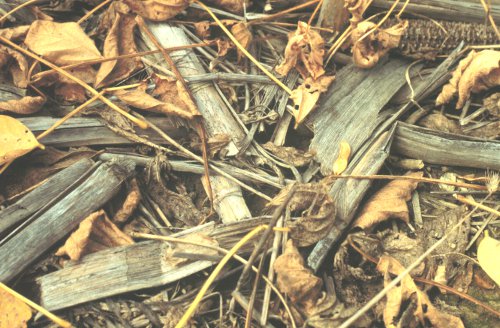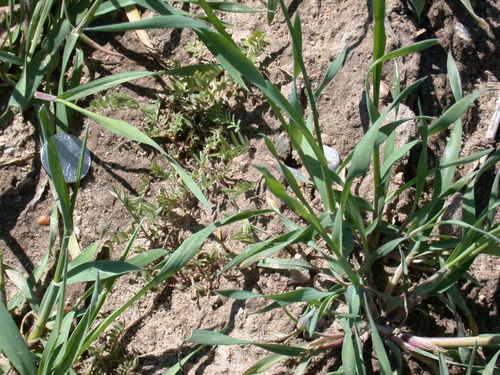eOrganic authors:
Sieglinde Snapp, Michigan State University
Emily May, Michigan State University
What is Soil Organic Matter?
Soil organic matter (SOM), the fraction of soil made up of decomposing plant or animal material, is the foundation for productive soil. The composition and breakdown rate or turnover of SOM affect soil structure, porosity, water infiltration rate, moisture holding capacity, and nutrient availability.

Figure 1. Decomposing plant residues—roots and stover—are the primary source of soil organic matter. Photo credit: Ed Zaborski, University of Illinois.
SOM is in a constant state of flux as crop residues, manure, and other organic materials are broken down and replace materials that are mineralized (converted to an inorganic form through microbial decomposition). Generally, SOM can be divided into three fractions or pools with different rates of turnover. These are known as the active, slow, and stable SOM pools.
Active SOM
The active SOM pool has a rapid turnover time, varying from weeks to years. It is very important for nutrient release. The active pool is primarily composed of recent plant residues in the early stages of decomposition and soil organisms, including microorganisms. Because the microorganisms in this fraction of the soil decompose very quickly when they die, part of the active SOM pool can have turnover times of days or weeks.
The active SOM pool and some of the more recalcitrant soil organic components, together with microorganisms, are involved in binding small soil particles into larger aggregates. Aggregation is important for good soil structure, aeration, water infiltration, and resistance to erosion.
Slow SOM
The slow SOM pool has a turnover time that varies from years to decades, and it exerts a strong influence on the physical condition and nutrient buffering capacity of the soil. The slow SOM pool is also an important source of nitrogen and phosphorus. This pool includes decomposed residues and microbial byproducts that are stabilized through physical and biochemical processes. Like the active SOM pool, some of the organic matter in this pool aids in the formation of soil aggregates. These aggregates provide both physical and chemical protection for organic matter.
Stable SOM
The stable SOM pool, sometimes called the passive pool or humus, consists of material that is hundreds to thousands of years old. It includes forms of carbon that are highly resistant to decomposition, and it is important for both the cation exchange capacity of the soil and for soil physical processes such as aggregation. The amount of stable SOM tends to be higher in soils with high clay concentrations, and it is not strongly influenced by recent management practices. However, management practices such as residue removal, burning, tillage, and crop rotation can have long-term effects on the amount of stable SOM.
Why Manage SOM?
SOM affects the chemical and physical properties of soil. It promotes healthy crops; supplies nutrient and energy sources for microbes and other soil organisms; and regulates the supply of water, air, and nutrients to plants. Soils with sufficient SOM typically have an increased capacity to hold water and suppress disease, resist compaction, require less fertilizer, and produce higher yields than soils depleted of SOM.
Conventional farming systems have generally reduced soil organic matter levels through repetitive harvesting and tillage, without efforts to replenish nutrients and restore soil quality. Increasing soil organic matter through a variety of conservation practices can enhance productivity and environmental quality while also helping to mitigate climate change by stabilizing carbon in the soil.
Managing Soil Organic Matter
There are two main approaches to building soil organic matter:
1. Slow down decomposition rates
Reducing the number of tillage operations or the intensity of tillage can increase SOM, especially over the long term. Tillage aerates the soil with oxygen, thereby accelerating decomposition and resulting in the "burn-off" of SOM in the form of carbon dioxide. Reduced tillage and no-till practices reduce the amount of soil disturbance and leave a surface cover of residues that protect against the erosive forces of wind and water, thus conserving high-carbon surface soils. In a long-term cropping system trial in southwest Michigan, no-till management enhanced soil C in the topsoil by about 40 percent (Grandy and Robertson, 2007). Another long-term study found that reduced tillage is most effective at enhancing SOM when combined with rotations or cover crops that include deep-rooting and high-residue-producing plants such as alfalfa (Franzluebbers, 2010). Reducing tillage and keeping the soil covered with growing crops or cover crops is particularly important for reducing the loss of SOM in areas of the U.S. with hot humid climates such as the Southeast.
2. Enhance carbon inputs from organic materials
Adding carbon-rich organic materials to the soil—for example, by leaving crop and cover crop residues in place or by applying manure amendments—is essential to building SOM. Crop residues include inputs from roots, which are crucial to enhancing the slow and stable SOM pools. Rotation with a legume hay crop or pasture is highly effective at improving SOM, as legumes generally have large taproot systems with tissues that are slow to decompose. Researchers in Michigan found that alfalfa production enhanced soil C by 60 percent, compared to a conventionally tilled corn–soybean–wheat rotation (Grandy and Robertson, 2007). Researchers in the Southeast have shown that annual crop residue additions of 10,000 lbs per acre can be necessary to maintain SOM in that climate (Bruce et al., 1995)
The characteristics of different kinds of organic matter inputs are illustrated in Table 1. Some materials supply large amounts of carbon and have the right qualities to build the stable and slow organic matter pools, and other materials supply nutrients and are high-quality inputs that help build the active SOM pool. The recommended management practice is to promote a mixture of the two types of materials.
| Residue Quality | Poultry Manure | Slurry Manure (Swine or Beef) | Dairy Manure | Wheat straw1 | Legume roots and leaves2 |
|---|---|---|---|---|---|
| 1 Stover from other small grains such as rye or barley has similar properties | |||||
| 2 Legumes grown in rotation as forage or cover crops provide inputs from leaves which are high in nitrogen and root tissues, which have moderate nitrogen levels and are relatively slow to decompose | |||||
| N content | 2–4% | 1–3% | 1–4% | <1% | 2–5% |
| C content | 19–28% | 14–23% | 16–45% | 45% | 45% |
| C:N ratio | 5–14 | 4–25 | 11–45 | 40 or higher | 25 or lower |
| pH | Neutral to Alkaline | Acidic | Neutral | Neutral | Neutral |
| Quality: for active SOM (nutrient supply) | High | Medium | Low-Medium | Low | High |
| Quality: for stable SOM (build C) | Low | Low | Medium-High | High | Low–Medium |
High-quality residues for building the active pool are generally immature tissues with soluble, available N-enriched compounds (proteins, for example), as well as soluble carbon compounds (such as sugars). The C:N ratio is used as a measure of N-enrichment and availability. A C:N ratio below 25 promotes rapid decomposition and mineralization of N. Residues with a C:N ratio greater than 25 may require additional soil N to break down but will persist longer in the soil and contribute more to SOM pools. Managing a combination of high-quality and low-quality residues with fertilizer approved for use in organic farming systems can maximize yield potential in many crops (Snapp et al., 2003).

Figure 2. Young vegetative tissues from cover crops, such as this winter rye and hairy vetch, provide a mixture of residue qualities that help build active and slow pools of soil organic matter. Photo credit: Sieg Snapp, Michigan State University.
An Integrated Approach to SOM Management
Efforts to manage SOM to improve crop productivity and environmental quality need to focus on increasing the concentration of C in all three pools. Diversifying residue inputs and reducing tillage intensity must be maintained over the long-term in order to build SOM in all three pools. Short-term improvements in management of several years or less may have some effect on the active pool C, but will have little if any effect on the slow and stable pools. And while adding organic materials is important for building SOM in all three pools, the key to building stable SOM is time. Adding too much organic material too quickly can be counterproductive, leading to nutrient imbalances (read more about organic soil fertility) and pest management problems that negatively impact crop quality and yields. Management practices designed to increase SOM in the slow and active pools will gradually increase the stable pool.
Conclusions
Soil organic matter consists of different pools, ranging from a short-term, active SOM pool to a long-term, stable SOM pool. There is growing evidence that a mixed quality of residues is effective at enhancing SOM pools by supporting a diverse soil food web. However, it is difficult to predict SOM responses for specific soil types and crop rotations. Soil organic matter responses occur over a long time frame, often of a decade or more. It is important for farmers to check any soil quality promotion claim for an organic amendment, manure type, or residue management practice. Try the product or practice on a small part of the farm—on an economically modest scale—before committing to any large changes in management practices.
This eOrganic article was based on MSU Extension Bulletin E-3137 (Snapp and Grandy, 2011).
References and Citations
- Bruce, R. R., G. W. Langdale, L. T. West, and W. P. Miller. 1995. Surface soil degradation and soil productivity restoration and maintenance. Soil Science Society of America Journal 59: 654–660. (Available online at: https://www.soils.org/publications/sssaj/abstracts/59/3/SS0590030654) (verified 13 July 2011).
- Doll, J. E., and S. S. Snapp. 2009. Sustainable crop removal: Maintaining soil quality. Extension Bulletin E3079. Michigan State University Extension, East Lansing, MI. (Available online at: http://web2.msue.msu.edu/bulletins/Bulletin/PDF/E3079.pdf) (verified 13 July 2011).
- Franzluebbers, A. J. 2010. Achieving soil organic carbon sequestration with conservation agricultural systems in the southeastern United States. Soil Science Society of America Journal 74: 347–357. (Available online at: http://dx.doi.org/10.2136/sssaj2009.0079) (verified 13 July 2011).
- Grandy, A. S., and G. P. Robertson. 2007. Land-use intensity effects on soil organic carbon accumulation rates and mechanisms. Ecosystems 10: 58–73. (Available online at: http://dx.doi.org/10.1007/s10021-006-9010-y) (verified 13 July 2011).
- Rector, N., T. M. Harrigan, D. R. Mutch, and S. S. Snapp. 2009. Cereal rye: Manure and livestock’s new best friend. p. 21–24. In: Manure $ense, Feb. 2009. (Available online at: http://www.animalagteam.msu.edu/animalagteam/cereal_rye_manure_and_livestocks_new_best_friend) (verified 13 July 2011).
- Snapp, S. S., J. Nyiraneza, M. Otto, and W. W. Kirk. 2003. Managing manure in potato and vegetable systems. Extension Bulletin E2893. Michigan State University Extension, East Lansing, MI. (Available online at: http://vegetable.msue.msu.edu//Resources/E2893MANURE.pdf) (verified 13 July 2011).
- Snapp, S. S., and A. S. Grandy. 2011. Advanced soil organic matter management. Extension Bulletin E-3137. Michigan State University Extension, East Lansing, MI. (Available online at: http://www.michiganorganic.msu.edu/uploads/files/31/E-3137_Building_Soil_Organic_Matter.pdf) (verified 13 July 2011).
- Six, J., and J. D. Jastrow. 2002. Organic matter turnover. p. 936–942. In R. Lal (ed). Encyclopedia of soil science. Marcel Dekker, Inc., New York, NY.
- Thelen, K. D., B. E. Fronning, S. A. Kravchenko, D. -H. Min, and G. P. Robertson. 2010. Integrating livestock manure with a corn-soybean bioenergy cropping system improves short-term carbon sequestration rates and net global warming potential. Biomass and Bioenergy 34: 960–966. (Available online at: http://dx.doi.org/10.1016/j.biombioe.2010.02.004) (verified 13 July 2011).



